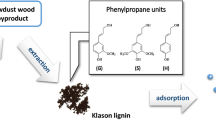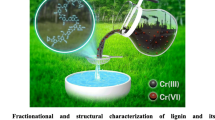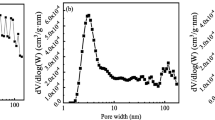Abstract
The possibility of using lignin from the paper industry’s black liquor to absorb nickel (Ni) and vanadium (V), was studied. The work comprised two stages: first, the identification of lignin’s main functional groups and the surface characterization of the solid; second, an experimental study of lignin’s behavior towards the Ni and V cations. Results revealed the presence of aromatic groups as well as substituted methoxy groups on the lignin’s surface. This explains lignin’s adsorptive capacity exhibited in the experimental evaluations. The removal of Ni and V ions was higher than expected solely through the physical adsorption mechanism. This higher capacity is associated with a proposed complex formation on the surface of the lignin. For Ni(II), lignin showed a higher adsorption compared to commercial adsorbents. In the case of V, the behavior is reversed, in order to elucidate this result, further research is recommended.
Similar content being viewed by others
References
Bailey, S.E., T.J. Olin, R.M. Bricka, and A. Dean, “A Review of Potentially Low-Cost Sorbents for Heavy Metals,” Water Res., 33, 2469–2479 (1999).
Barrow, G.H., Fisicoquímica, pp. 121–140, Editorial Reverté, Spain, 1964.
Basso, M.C., E.G. Cerrella, and A.L. Cukierman, “Lignocellulosic Material as Potential Biosorbents of Trace Toxics Metals from Wastewater,” Ind. Eng. Chem., 41, 3580–3585 (2002a).
Basso, M.C., E.G. Cerrella, and A.L. Cukierman, “Activated Carbons Developed from a Rapidly Renewable Bioresource for Removal of Cadmium (II) and Nickel (II) Ions from Dilute Aqueous Solutions,” Mater. Interfaces, 41, 180–189 (2002b).
Boehm, H.P., “Surfaces Oxides on Carbon and Their Analysis: A Critical Assessment,” Carbon, 40, 145–149 (2002).
Boeriu, C., D. Bravo, R. Gosselink, and J. Van Dam, “Characterization of Structure-Dependent Functional Properties of Lignin with Infrared Spectroscopic,” Ind. Crops Prod., 20, 205–218 (2004).
Crist, R.H., J.R. Martin, and R.D. Crist, “Use of a Novel Formulation of Kraft Lignin for Toxic Metal Removal from Process Waters,” Sep. Sci. Technol., 39(7), 1535–1545 (2004).
Cussler, E.L., Diffusion, pp. 309–329, Cambridge University Press, U.S.A., 1997.
De Chamorro M. and M. Romano, “Simultaneous Demetallization and Desulphuration of Carbonaceous Materials Via Microwaves,” U.S. Patent no 6.038.777 (2000).
Dermibas, A., “Adsorption of Lead and Cadmiun Ions in Aqueous Solutions Onto Modified Lignin from Alkali Glycerol Delignification,” J. Hazard. Mater., B109, 221–226 (2004).
Dizhbite, T., G. Zakis, A. Kisima, E. Lazareva, G. Rossinskaya, V. Jurkjane, G. Telysheva, and U. Viesturs, “Lignin a Useful Bioresource for the Production of Sorption-Active Materials,” Bioresour. Technol., 67, 221–228 (1999).
Dupont, L. and E. Guillon, “Removal of Hexavalent Chromium with a Lignocellulosic Substrate Extracted from Wheat Bran,” Environ. Sci. Technol., 37, 4235–4241 (2003).
Jankowska, H., A. Swiatkwski, and J. Choma, Active Carbon, pp. 254–259, Edit. Ellis Horwood Limited, England, 1991.
Gregg, S. and K. Sing, Adsorption, Surface Area and Porosity, pp. 110–115, Academic Press. London, 1982.
Lalvani, S.B., T.S. Wiltowski, D. Murphy, and L.S. Lalvani, “Metal Removal from Process Water by Lignin,” Environ. Technol., 18, 1163–1168 (1997a).
Lalvani, S.B., T.S. Wiltowski, and A. Weston, “Metal Ions Removal from Wastewater by Adsorption,” ACS, Division of Fuel Chemistry, 42(3), 877–879 (1997b).
Lalvami, S.B., A. Hubeeer, T.S. Wiltowski, and D. Murphy, “Chromium Adsorption by Lignin,” Energy Sources, 22, 45–56 (2000).
Lee, J.M., J.J. Baker, D. Murray, and J.G. Rolle, “Quality Analysis of Petroleum Cokes and Coals for Export Specifications Required in use of Specialty Products and Utility Fuels,” Preprints of Symposia, 214th National Meeting American Chemical Society, 47, 844–853 (1997).
Levine, I., Fisicoquímica, pp. 380–392, McGraw-Hill, Mexico, 1996.
Martín, R.J., “Activated Carbon Product Selection from Water and Wastewater Treatment,” Ind. and Eng. Chem. Prod. Res. and Dev., 19(3), 411–435 (1980).
Morrison, R. and R. Boyd, Química Orgánica, pp. 808–834, Fondo Educativo Interamericano, S.A., U.S.A., 1976.
O’Neil, D.J., C.J. Newman, P.M. Hawley, E.S. Chian, H. Gao, and J.M. Kim, “The Utility of Pristine Lignin for Hazardous Waste Treatment,” Energy from Biomass and Wastes, 10, 1683–1684 (1987).
Parajuli, D., I. Katsutoshi, O. Keisuke, O. Tatsuya, M. Atsushi, and M. Funaoka, “Adsorption of Heavy Metal on Crosslinked Lignocatechol: A Modified Lignin Gel,” Reactive and Functional Polymers, 62, 129–139 (2005).
Pérez N., G. Rincón, L. Delgado, N. González, and D. Itriago, “Use of Remainders of the Industry of Paper Manufacture in the Extraction of Nickel from Petroleum Coke,” in Proceeding of the XVI Congresso Brasileiro de Engenharia Química, CD, 2006.
Perineau, F. and A. Gaset, “Adsorption of Ionic Solutes on Acidic Lignin Wastes,” J. Chem. Technol. Biotechnol., 31(12), 711–716 (1981).
Ray, H.C., R.J. Martin, and D.R. Crist, “Heavy Metals Uptake by Lignin: Comparison of Biotic Ligand Models with an Ion-Exchange Process,” Environ. Sci. Technol., 63, 1485–1490 (2002).
Roper, W., “Toxicological Profile for Vanadium and Compounds,” Agency for Toxic Substances and Disease Registry, U.S. Public Health Service (1992).
Rouchi, A.M. and C.E. Washington, “Only Facts will end Lignin War,” Sci. Technol., 79(14), 52–56 (2001).
Rupp, E.B. and P. Zuman, “Polarographic Determination of Some Pesticides. Application to a Study of their Adsorption on Lignin,” J. of Agric. Food Chem., 40, 2016–2021 (1992).
Sarkanen, K.V. and C.H. Ludwing, Lignins, Ocurrence, Formation, Structure and Reactions, pp. 23–95, John Wiley & Sons, Inc., New York, 1971.
Sciban, M. and M. Klasnja, “Study of the Adsorption of Copper (II) Ions from Water Onto Wood Sawdust, Pulp and Lignin,” Sci. Technol., 22(3), 195–206 (2004).
Sharma, Y.C., G. Prasad, and D.C. Rupainwar, “Removal of Nickel (II) from Aqueous Solutions by Sorption,” J. Environ. Stud., 37, 183–191 (1991).
Silverstein, R.M., G.C. Bassler, and T.C. Morrill, “Spectrometric Identification of Organic Compound,” Vib. Spectrosc., 10, 123–124 (1992).
Skoog, D. and D. West., Fundamentos de Química Analítica, Editorial Reverté, pp. 305–320, Spain, 1977.
Srivastava, S.K., A.K. Singh, and A. Sharma, “Studies on the Uptake of Lead and Zinc by Lignin Obtained from Black Liquor- a Paper Industry Waste Material,” Environ. Technol., 15(4), 353–361 (1994).
Swiatkowski, A., G. Szymanski, and S. Biniak, Fundamentals of Adsorption, pp. 40–120, Elsevier, U.S.A., 1996.
Wieber J., F. Kulik, A. Phetica, and P. Zuman, “Sorptions on Lignin, Wood and Celluloses. Copper (II) and Zinc (II) Ions,” Colloids Surf., 33, 121–132 (1988).
Zhuang, J.M., T. Walsh, and T. Lam, “A New Technology for the Treatment of Mercury Contaminated Water and Soils,” Environ. Technol., 24(7), 897–902 (2003).
Author information
Authors and Affiliations
Corresponding author
Rights and permissions
About this article
Cite this article
Pérez, N.A., Rincón, G., Delgado, L.A. et al. Use of biopolymers for the removal of heavy metals produced by the oil industry—A feasibility study. Adsorption 12, 279–286 (2006). https://doi.org/10.1007/s10450-006-0504-x
Received:
Revised:
Accepted:
Issue Date:
DOI: https://doi.org/10.1007/s10450-006-0504-x




